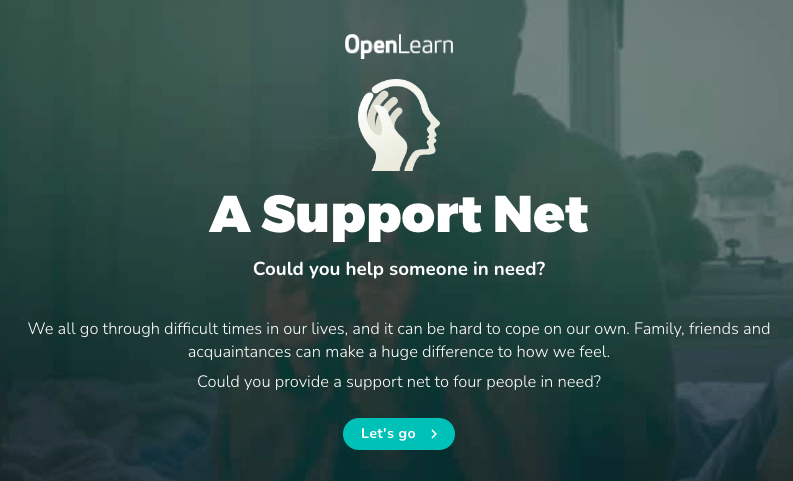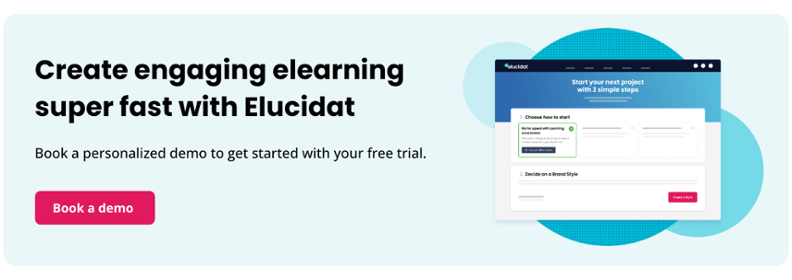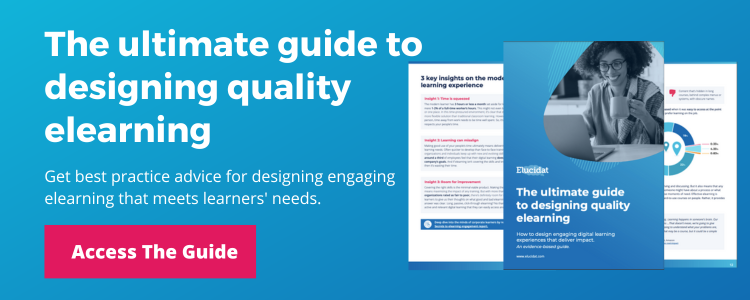Interactive elearning: everything you need to know
8 minute read
Let’s face it, the days of sitting through stale lectures and drab training materials for hours on end are over. Today’s employees are bored of outdated training programs and need something more exciting to get the learning juices flowing. This is where interactive elearning comes into play. Here, we’ll explore how to make elearning interactive, types of interactivity in elearning, best practices for designing and implementing it, and much more.

What is interactive elearning?
Interactive elearning is a dynamic and engaging way of learning that allows learners to actively participate in the process. Gone are the days of sitting, listening and, frankly, being overwhelmed by information and jargon. This is learning by doing. Interactive elearning is all about creating a fun and immersive learning experience.
This type of elearning leans on a variety of elements, such as branching scenarios, interactive videos, and even simulations. These elements help learners to stay focused and better retain the information at hand.
What are the benefits of interactive elearning?
More than a buzzword or elearning trend, interactive corporate training can be a game-changer in the right hands. Here’s a look at some of the benefits of utilizing this concept.
- Engagement and knowledge retention: As mentioned, interactive materials are a great way to make learning stick. With a dynamic, ever-shifting array of elements at hand, learners will never slip into autopilot. Keeping them engaged is half the battle when trying to get a message across. Ultimately, you can create interactive elearning that’s fun, and provides a rewarding experience to your employees.
- Enhanced collaboration: Interactive elearning can also improve collaboration and teamwork among learners. It facilitates social learning, which allows learners to share knowledge and collaborate with others, promoting a sense of community and teamwork within the organization.
- Risk-free environment: Elearning interactivity has the capabilities of replicating real-world situations. Relatable simulations encourage decisiveness in a safe environment without the risks that could arise in real scenarios.
- For example, interactive simulations are used in the medical field to put learners in life and death decision making situations. This allows experience to be garnered without being thrown into the deep end in real life. Simulations like this results in learners who are better prepared for situations they may be thrust into.
- For example, interactive simulations are used in the medical field to put learners in life and death decision making situations. This allows experience to be garnered without being thrown into the deep end in real life. Simulations like this results in learners who are better prepared for situations they may be thrust into.
- Real-time feedback: With interactive elearning, learners can receive real-time feedback on their progress, helping them to identify areas of strength and weakness as they navigate through the course. The interactivity aspect means that they can make improvements on the fly and try out different responses to areas that they’re struggling with.
- The best interactive elearning examples will guide learners along the path by providing status updates or highlighting incorrect responses. This feedback can be used to tailor their learning experience, resulting in more efficient and effective training.
- The best interactive elearning examples will guide learners along the path by providing status updates or highlighting incorrect responses. This feedback can be used to tailor their learning experience, resulting in more efficient and effective training.
- Flexibility: One of the biggest advantages of interactive elearning is its flexibility. Learners can access the material at any time, from any location, and at their own pace. This makes it easier for learners to balance their work and personal lives with their training.
What makes interactive elearning different from traditional elearning?
Traditional elearning often delivers content in a linear, passive format – think reading slides, watching a video, and ticking a quiz box. Interactive elearning flips the model by putting learners in control.
Instead of just consuming information, they’re doing something with it. And that’s the key to better outcomes – and better learning experiences.
Types of interactive elearning
Interactive elearning is a catch-all term for an array of different elearning methods. There are many types of tools and techniques available to help learners engage with the material. Here are the types most worthy of discussion:
Gamification
Gamification involves incorporating game-like elements into the learning experience. This can include things like leaderboards, badges, and interactive quizzes that help learners to stay motivated and engaged. Gamification can be applied to a variety of learning contexts, from compliance training to soft skills development.

Simulations and scenarios
Simulation-based training involves creating a virtual environment in which learners can practice real-world skills and problem-solving. For example, a sales simulation might allow learners to practice sales techniques in a safe and controlled environment. This type of interactive elearning is particularly effective for developing skills that require hands-on experience.

Interactive videos
Interactive videos are a great way to engage learners and promote knowledge retention. They can include things like quizzes, branching scenarios, and annotations that allow learners to interact with the content. Interactive videos are often used for compliance training and soft skills development.

Virtual reality
Virtual reality allows learners to experience immersive, 360-degree environments that simulate real-world scenarios. This type of interactive elearning can be used for everything from safety training to customer service training. Virtual reality is particularly effective for training in high-risk or high-stress environments.
Augmented reality
Augmented reality involves overlaying digital information in the real world. For example, an augmented reality training program for mechanics might involve overlaying instructions and diagrams onto a physical engine. Augmented reality is a great way to provide learners with contextual information and guidance.
5 tips for designing interactive elearning
When it comes to designing effective interactive corporate elearning, there are several key factors to consider. Here are some expert tips for creating engaging and interactive elearning experiences:
1. Identify your learning objectives
The first step of any effective elearning program is identifying your learning objectives. What do you want your learners to be able to do or know after completing the training? Once you’ve identified your objectives, you can design your interactive elements to meet those goals.
2. Select appropriate interactive elements
As outlined, there are many types of interactive features that can be incorporated. When selecting interactive elements, it’s important to choose tools and techniques that align with your learning objectives and that will resonate with your audience. Be sure to identify the ways in which your employees learn and apply your methods to them.
3. Create engaging content
One of the key reasons you’d turn to interactive elearning is keeping learners engaged and motivated. To create engaging content, it’s important to use a variety of media and techniques, including graphics, videos, audio, and interactive elements. Incorporating storytelling and real-world examples can also help to make the content more relatable and interesting.
4. Feedback and evaluation
Feedback is a crucial component of any elearning program. It helps learners to understand their strengths and weaknesses and to identify areas for improvement. Providing frequent and constructive feedback can help to keep learners engaged and motivated, and can also help to improve knowledge retention and transfer.
5. Incorporate social learning
Social learning involves using collaboration and discussion to help learners build knowledge and skills. Incorporating social learning elements, such as group activities and discussion forums, can help to create a sense of community among learners and can also help to reinforce key concepts and skills.
How to implement interactive elearning
Implementing interactive corporate elearning can appear complex, but with the right strategies and tools, it can be a highly effective way of improving training outcomes. Here are a few tips for implementing interactive elements into your training program.
Choose the right software
It goes without saying, elearning authoring tools and the right LMS can make or break your training program. When selecting your tools, it’s important to consider factors such as ease of use, scalability, and the ability to track and report on learner progress. Look for authoring tools and an LMS that supports the types of interactive elearning activities you plan to use and that integrates well with your existing technology infrastructure.
Read more: Top elearning LMS platforms
Measure training effectiveness
To ensure that your interactive elearning program is meeting your learning objectives, it’s important to measure its effectiveness. This might involve tracking learner engagement and completion rates, monitoring progress and performance, or conducting assessments to measure knowledge retention and transfer.
Addressing challenges in implementation
Implementing interactive elearning can present a range of challenges, from technical issues to resistance from learners. To overcome these challenges, it’s important to have a plan in place for addressing issues as they arise. This might involve providing technical support, addressing learner concerns through communication and feedback, or adjusting the program to better meet learner needs.
Best practices for interactive elearning
In order to create effective interactive elearning, you need to adhere to some best practices. These are in place to ensure that your content is fully optimized for the learner. Here, there’s a handful of best practices to keep in mind when designing interactive elearning.
- Incorporate storytelling – Stories have been used for centuries to teach important lessons and convey complex ideas in a way that resonates with learners. By incorporating storytelling elements into your elearning, you can make it more memorable and engaging for your learners, with a narrative to follow throughout the materials.
- Use real-life scenarios – One of the most effective ways to help learners apply new knowledge and skills is to present them with real-life scenarios that they might encounter in their work. By providing learners with opportunities to practice their skills in realistic contexts, you can help them to build confidence and competence.
- Personalizing the experience – No two learners are alike, and everyone has different learning preferences and needs. By personalizing the learning experience, you can help learners to feel more invested in the learning process. This might involve providing customized content based on learners’ interests and goals or using adaptive learning technologies to adjust the pace and difficulty of the learning experience to match each learner’s needs.
- Accessibility – In today’s diverse and inclusive workplace, it’s important to ensure that elearning is accessible to all learners, regardless of factors such as disabilities. This might involve providing closed captioning for video content, using alt text for images, or ensuring that the elearning platform is compatible with assistive technologies. Similarly, it will need to be within reach for global employees.
Choosing Elucidat for interactive elearning
Interactive elearning offers numerous benefits for organizations looking to upskill their workforce and drive business success. If you’re looking to design an interactive elearning course, you need an authoring tool that can handle interactive elements. Enter Elucidat.
Elucidat’s authoring tool is designed to produce impactful elearning experiences – check out our showcase for inspiring examples of interactive elearning. If you’re ready to see how we can help you create interactive elearning, book a demo today.





